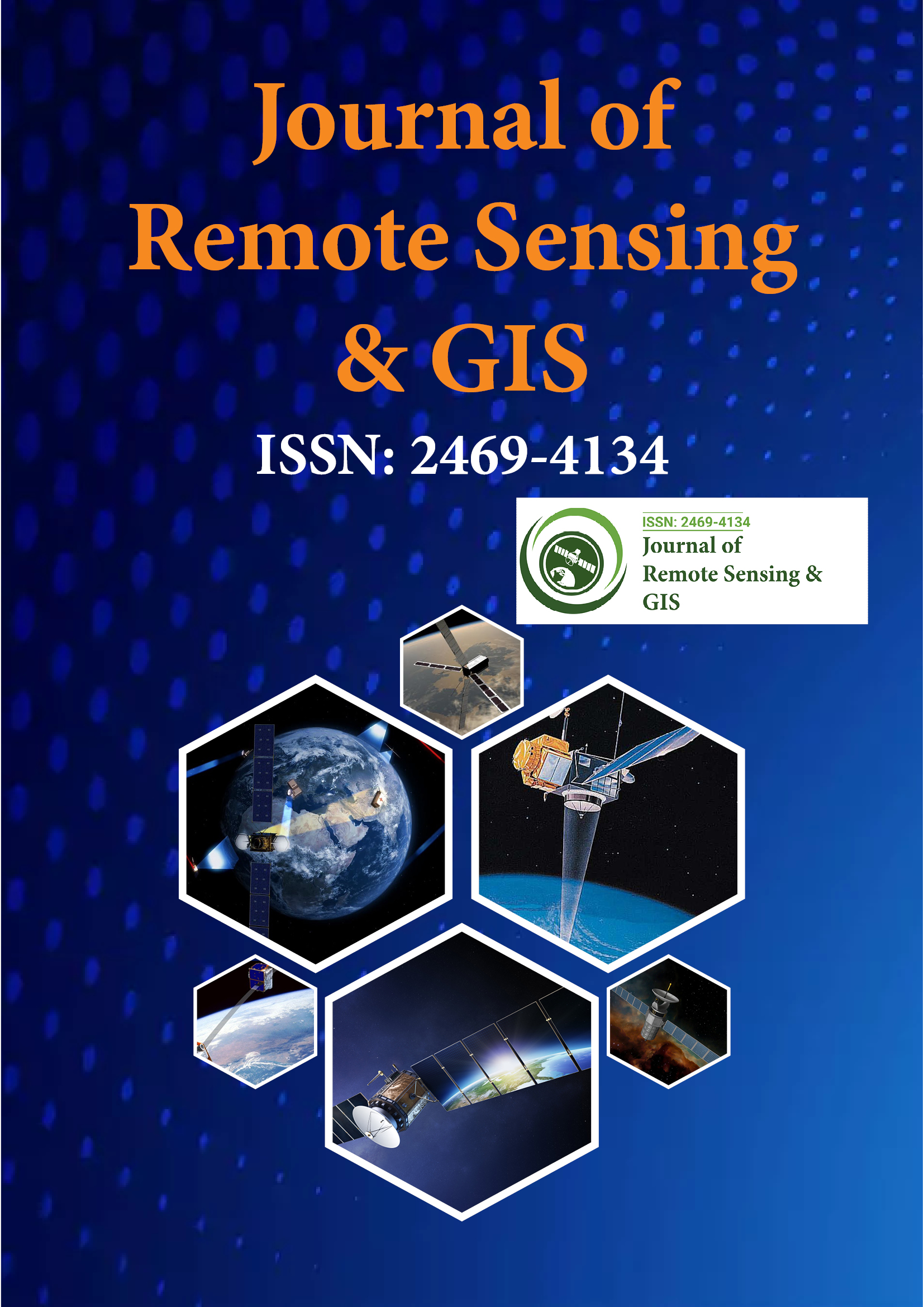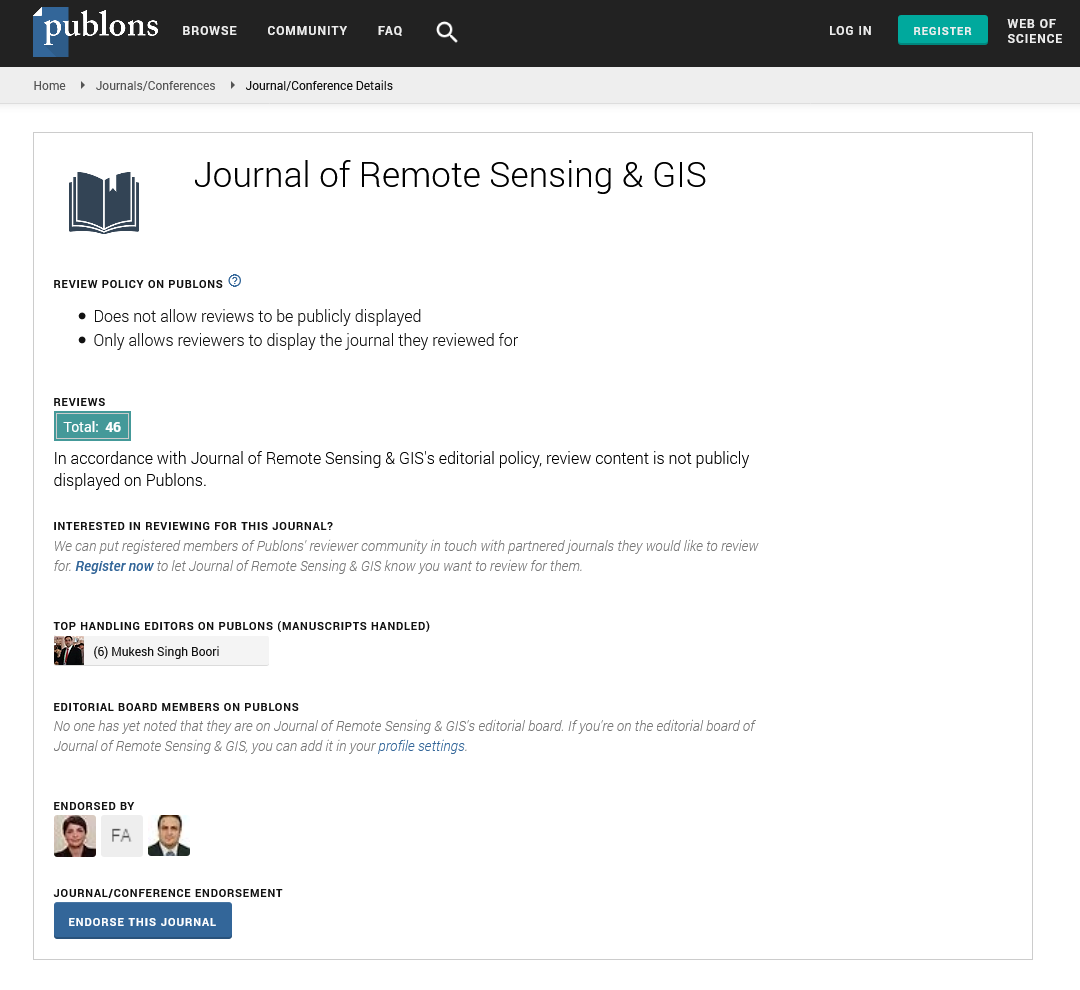Indexed In
- Open J Gate
- RefSeek
- Hamdard University
- EBSCO A-Z
- OCLC- WorldCat
- Publons
- International Scientific Indexing
- Euro Pub
- Google Scholar
Useful Links
Share This Page
Journal Flyer

Open Access Journals
- Agri and Aquaculture
- Biochemistry
- Bioinformatics & Systems Biology
- Business & Management
- Chemistry
- Clinical Sciences
- Engineering
- Food & Nutrition
- General Science
- Genetics & Molecular Biology
- Immunology & Microbiology
- Medical Sciences
- Neuroscience & Psychology
- Nursing & Health Care
- Pharmaceutical Sciences
Editorial - (2020) Volume 9, Issue 2
Science and Applications of Remote Sensing
Siqing Q*Received: 11-Mar-2020 Published: 01-Apr-2020, DOI: 10.35248/2469-4134.20.9.e112
Editorial
Remote sensing is a critical tool for the observation of the systems on commensurate spatial scales. This Research Topic looks at coastal applications of remote sensing for scientific research and applications, along with the challenges associated with acquiring and using these data. This non-exhaustively includes observations of water column constituents (e.g., phytoplankton pigments, species composition, suspended organic and inorganic particles); sea surface temperature (SST) and sea surface height (SSH); watershed evapotranspiration, soil moisture, and land cover/land use; wetland emergent vegetation, submerged aquatic vegetation, and coral reefs. Existing and planned remote sensing instruments, with a variety of spectral, spatial, temporal, and radiometric ranges and resolution, are offering new views on coastal systems. Articles in this Topic explore the latest interdisciplinary research, and consider how this technology can guide future development and utilization of coastal aquatic remote sensing resources (in situ, airborne, and satellite) and better inform public policy.
Now a new open access journal of LONGDOM Publishing Group, Journal of Geophysics & Remote Sensing, has appeared. It will play an important role in developing high-accuracy and efficient algorithms in seismic numerical modeling and migration imaging among diverse topics of geophysics and remote sensing. A very attracting feature of LONGDOM Publishing Group ’ s publications is that user-friendly websitetranslation of published papers to more than 50 languages is available and the readers can choose the language to read the papers and more than 25+ Million Readers database. This feature further strengthens the function of the traditional journals as a communication platform for worldwide researchers. An ancient Chinese philosopher Lao-Zi said, “A saint does not hide his/her knowledge. The more he/she gives to others, the more he/she gets from others. ” This demonstrates the importance and benefits of communication. Worldwide researchers can benefit from communication by using the flexibility and interactive nature of Journal of Geophysics & Remote Sensing.
Some of the innovative research topics by the Eminent authors in our Journal are
Amproche et al. describes the study assessed the Land use/cover (LULC) changes within the Basin for a period of eighteen years, and mapped current and potential mining hotspots in the Basin. The study used multispectral Landsat images for the years 2000, 2015 and 2018. Supervised classification method and Spectral Angle Mapper were used to classify and map the LULC types. Feature-based extraction method was then used to delineate mining sites along the River in the Basin. Six (6) LULC types were classified. Findings from the study revealed that four of the classified LULC experienced some form of decline between the years 2000 and 2018, except Bareland and settlements which consistently increased within the period, with Barelands recording the highest increase of 21% between 2000 and 2015 and 18% between 2015 and 2018, signaling a sharp increase in the three year period.
Maina et al. describes Assessment of Land Use and Land Cover Change Using GIS and Remote Sensing: A Case Study of Kieni, Central Kenya which explains about the To investigate land use land cover changes (LULCC) in the Kieni sub-county in Central Kenya from 1987 to 2017, remote sensing and Geographical Information System (GIS) was used. This was done by downloading and processing landsat images of 1987, 1995, 2000, 2010 and 2017. Methods employed were, data identification and acquisition, image processing, validation and presentation. There were six classifications analysed which were; bare areas, bushlands, farmlands, forest, grasslands and waterbodies. The results showed an increase in the classes of water bodies, farmlands and bare areas by 314.86%, 160.45% and 73.18% respectively over the 30-year period. The results also showed a decrease in the land use land cover classes categories of forest, bushlands and grassland by 45.94%, 38.73% and 29.66% respectively.
Citation: Siqing Q (2020) Science and Applications of Remote Sensing. J Remote Sens GIS. 9:e112. DOI: 10.35248/2469-4134.20.9.e112
Copyright: 2020 Siqing Q. This is an open-access article distributed under the terms of the Creative Commons Attribution License, which permits unrestricted use, distribution, and reproduction in any medium, provided the original author and source are credited.

